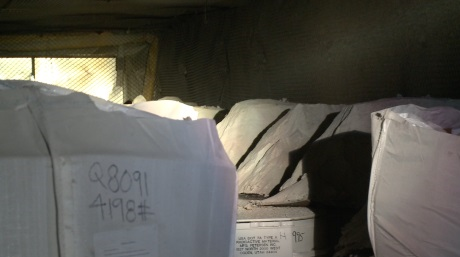More information keeps coming out about the February 14th accident at the Waste Isolation Pilot Plant which resulted in the release of particles of plutonium and americium into the environment around Carlsbad, New Mexico. There are reports that the radioactive isotopes have been found much further away from the plant. Twenty one people in the facility were exposed to radiation during the accident. The site has been closed since the accident with only a skeleton staff and investigators being allowed into the facility. The room where the radiation was released has been so hot that investigators were having problems entering the area where the radiation release occurred. It is still not clear at this time exactly what happened.
The plant accepts mildly radioactive waste, tools, clothes and other materials generated by the production of U.S. nuclear weapons. It is located in an old salt mine where drums of waste are piled in large open "panels" which are each divided into seven rooms. When a room is full, it is sealed off. Bags of magnesium oxide powder weighing up to two tons each are placed on top of the drums of waste to serve as backfill. In addition, if water found its way into the room after it was closed off, the magnesium oxide would combine with the water to form a compact solid, immobilizing the radioactive materials and prevent the water from dissolving them and washing them out of the room. The magnesium oxide powder also absorbs carbon dioxide.
Two theories of what caused the accident were put forward. One suggested that gases built up in a drum of waste and then exploded, damaging other drums. The other theory suggests that the roof of the room collapsed on the drums and damaged them. Using cameras on telescopic extensions, on April 30 the investigators were able see deep into the room where the accident occurred and were able to verify that there was no evidence of damage to either the ceiling or the walls of the room. What was found was that there was damage to some of the bags of magnesium oxide. Large piles of powder were found on top of other bags but there was no sign of the bags that should have contained the loose powder.
With respect to the other theory about gas build up there have been reports that testing for gas build up had been declining since the facility was put into operation. Inspectors are checking the processing of some of the last drums of waste that were placed in that room to see if they were vented within sixty days of arrival as required by regulations.
Ninety staff members of WIPP have completed training courses on facility operations and have just been allowed to return to the facility. "Upon returning to the site, workers will perform plant and equipment maintenance and restoration, radiological checks, sampling activities, and support work procedure revisions." Hopefully, the cause of the accident will be identified and dealt with before the facility is reopened to take waste.
Bags of magnesium oxide in the Waste Isolation Pilot Plant:
